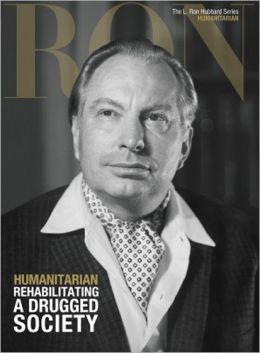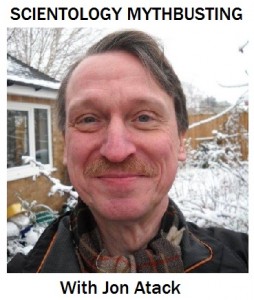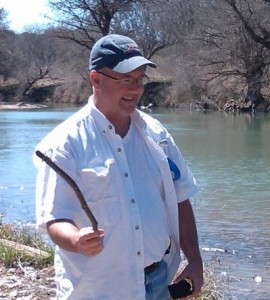 Jon Atack is the author of A Piece of Blue Sky, one of the very best books on L. Ron Hubbard and Scientology. He has a new edition of the book for sale, and on Saturdays he’s helping us sift through the legends, myths, and contested facts about Scientology that tend to get hashed and rehashed in books, articles, and especially on the Internet.
Jon Atack is the author of A Piece of Blue Sky, one of the very best books on L. Ron Hubbard and Scientology. He has a new edition of the book for sale, and on Saturdays he’s helping us sift through the legends, myths, and contested facts about Scientology that tend to get hashed and rehashed in books, articles, and especially on the Internet.
Jon, you’ve previously made some references to L. Ron Hubbard and drug use. But this week you wanted to take a closer look at what the man had to say about mind-altering substances and relate it to his development of Scientology. We figure we’re in for another wild ride, so take it away.
JON: Scientology promotes itself as utterly anti-drug, yet this was by no means the attitude of the Founder, who was much more in line with current, progressive “harm reduction” ideas. In 2010, the prestigious medical journal The Lancet published the largest survey of the social and individual harms of drugs to date, which concluded that the most dangerous drug in our society is alcohol. No one at Narconon or Say No to Drugs jumped up to point out that this reflected their own ideologue’s policy, but here it is, as stated in his 1950 work, Dianetics: the Modern Science of Mental Health:
Alcohol is rarely an assist to the auditor. In fact, alcohol is rarely an assist to anyone. A depressant, classifiable at best as a poison, alcohol has the single virtue of being highly taxable….Alcoholism is engramic. It has become, in some very understandable way, a class of contagious aberration whereby the reactive mind confuses alcohol and “being a good sport” or “having fun” or “forget your troubles.” Some of these things can also be obtained by strychnine and cyanide. Alcohol has its uses: one can put specimens of frogs and such in it: one can clean the germs off needles with it: it burns well in rockets. But one would not consider preserving his stomach in a glass jar and, unless insane, does not think of himself as a needle. While some drunks think they act like rockets, few have been observed to reach an altitude of more than the floor. It is not only a poor stimulant-depressant, it is also an hypnotic in the finest sense: what is done to a drunk becomes an engram….Opium is less harmful, marijuana is not only less physically harmful but also better in the action of keeping a neurotic producing, phenobarbital does not dull the senses nearly as much and produces less after effect, ammonium chloride and a host of other stimulants are more productive of results and hardly less severe on the anatomy: but no, the engrams, contaging unpleasantly along from the first crude brew which made one of our ancestors drunk, decree that alcohol is the only thing which is to be drunk if a person wants to “forget it all” and “have a good time.”
Despite these protests in D:MSMH, Hubbard had his own problems with alcohol. Barbara Snader said that while Hubbard was having an extramarital affair with her, at the end of 1950, he was drinking a bottle of Scotch a day, and struggling with despair and he tried to come up with some new therapy ideas. He next kidnapped baby Alexis and took her to Cuba, where his drinking, according to Richard de Mille, continued apace, but using the local rum. De Mille committed Hubbard’s thoughts during this period to print, in Science of Survival.
While the cult promotes abstinence from all except alcohol and tobacco — the second most dangerous drug in terms of ill health — it is also interesting to note that Hubbard advocated amphetamines, in the early years, as an aid to concentration in “processing:” “Benzedrine and some other commercial stimulants have been used with some success…” L. Ron Hubbard Jr. insisted that he was given speed by his dad for the “research” that would become Scientology: A History of Man.
THE BUNKER: Well, that helps explain a few things. We have to step in here and plug our reading of A History of Man with biologist and blogger PZ Myers, which was one of our favorite recent experiences. As you were saying, Jon…
JON: In one lecture, Hubbard bemoaned his own addiction to phenobarbital, which he struggled with throughout the creation of both Dianetics and Scientology. His last attempt to procure this powerful barbiturate came in 1965, when he tried to fill a prescription signed “Dr Hubbard” at an East Grinstead pharmacy. Of his earlier attempt to kick the habit, Hubbard said: “I made myself a guinea pig on one of those experiments, and trying to get off the soporific was a tough job. Completely aside from the physiological reaction, when one suddenly ceases to take phenobarbital one gets the kick-in of the locks. It is like hypnotizing a person, and giving him a positive suggestion, then waking him up. Here he has been listening for ten hours a day to engrams, engrams, engrams, and for a few days he doesn’t know whether he’s going or coming or walking around the block. That’s pretty gruesome.” (Research and Discovery, volume 1, p.124, first edition).
Hubbard had been given phenobarbital for his ulcers, back in the Navy, so his affair with them lasted for at least twenty years. His interest in drugs reached back long before his unglamorous navy career, however. Hubbard reckoned that his spiritual discoveries began in Spring 1938, when he had an out-of-body experience during an operation to remove his wisdom teeth. He claimed that he was dead for eight minutes, while under anaesthetic. The anaesthetic in question was nitrous oxide. In D:MSMH, Hubbard recommended the drug, thus: “nitrous oxide makes an excellent hypnotic for institutional [dianetic] therapy,” yet, on the same page, we find a warning, “Nitrous oxide engrams are particularly bad when they involve exodontistry; they often form the most severe late life engram.” (p.363). Hubbard said that during his eight dead minutes he saw a “smorgasbord” of knowledge, and that the command for him to forget this, when he was returned from the Pearly Gates, failed to take. From this experience came his revelation that survival is the fundamental drive of humanity, and he wrote his first text, “Excalibur,” to expound upon this principle.
 William Sargant, a well known psychiatrist, was labeled the “number one SP” in Britain by the Guardian’s Office, but that didn’t stop Hubbard from keeping a copy of his seminal Battle for the Mind in his office at the Washington, DC, Founding Church. After writing that fascinating text (which discusses what Hubbard was reading in the library at Oak Knoll Hospital, back in 1945 — Grinker and Spiegel’s work), Sargant travelled the world, observing the effects of various different rituals, which, in his opinion, were better at relieving minor mental illnesses than the techniques employed by psychiatrists. The Mind Possessed is a compendium of trance-inducing techniques, from Haitian Voodou to Christian snake-handling, which includes this insight into nitrous oxide: “Such revelations, whether they occur under drugs or during a schizophrenic illness, carry with them a certainty which can override the normal intellectual standards and attitudes of the person experiencing them.”
William Sargant, a well known psychiatrist, was labeled the “number one SP” in Britain by the Guardian’s Office, but that didn’t stop Hubbard from keeping a copy of his seminal Battle for the Mind in his office at the Washington, DC, Founding Church. After writing that fascinating text (which discusses what Hubbard was reading in the library at Oak Knoll Hospital, back in 1945 — Grinker and Spiegel’s work), Sargant travelled the world, observing the effects of various different rituals, which, in his opinion, were better at relieving minor mental illnesses than the techniques employed by psychiatrists. The Mind Possessed is a compendium of trance-inducing techniques, from Haitian Voodou to Christian snake-handling, which includes this insight into nitrous oxide: “Such revelations, whether they occur under drugs or during a schizophrenic illness, carry with them a certainty which can override the normal intellectual standards and attitudes of the person experiencing them.”
Sargant goes on to give descriptions of experiences under the influence of nitrous oxide. One patient spoke of “…everlasting hell. I lost all consciousness of my surroundings…It was this experience of being ‘caught in eternity’ which…I shall never forget as long as I live.”
Another patient wrote, “I thought I was near death; when suddenly my soul became aware of God, who was manifestly dealing with me, handling me, so to speak, in an intense personal present reality. I felt him streaming in like light upon me…I cannot describe the ecstasy I felt…[then] to find that I had after all no revelation, but that I had been tricked by the abnormal excitement of my brain…Is it possible that the inner sense of reality which succeeded, when my flesh was dead to impression from without, to the ordinary sense of physical relations, was not a delusion, but an actual experience? Is it possible that I, in that moment, felt what some of the saints have said they always felt, the undemonstrable but irrefragible certainty of God?”
Sargant goes on to quote from Professor J.H. Leuba, who says, “The universality of the mystical conviction is frequently offered as proof of its truth. But the truth of a belief is not proved by the fact that it is shared by all known men, most users of narcotics and many of the subjects of spontaneous trance regard its contents just as they do their dreams, i.e. as having no other than subjective reality.”
Sargant further cites Sir James Crichton-Browne’s comments on the nitrous oxide experience: “In persons of average mental calibre they are pleasant and stimulating but in no way remarkable; but in persons of superior mental power they become thrilling and apocalyptic. A working man describes it as if he had had a little too much beer, and a philosopher announces that the secret of the universe had been, for one rapt moment, made plain to him.”
I dwell upon this subject, because it is the moment of genesis for all of Hubbard’s spiritual revelations. Could it be that Dianetics and Scientology were simply Hubbard’s attempt to regain the ecstasy of those eight minutes? It is certainly true that his own guru, Aleister Crowley, threw his life into the pursuit of drug experiences, along the way creating the hypnotic method renamed by Hubbard “creative processing,” but Crowley fell down the vortex of drug use, ending up hopelessly addicted to heroin, where Hubbard found himself at the centre of an adulating cult, and kept very, very quiet about his continuous drug use.
We have to be suspicious of the techniques used by Narconon, as they clearly didn’t work for Hubbard. During filming in La Quinta, Hubbard complained that he could not quit smoking. Kima Douglas testified that when she gave up on him, he had cut down from 120 to 100 unfiltered cigarettes a day. Others who knew him (but would rather remain unharassed) have said that he talked about taking LSD, too.
I’ve come to expect that any claim by Hubbard will have an equal and opposite reality. This is certainly the case with drugs. And I hear that David Miscavige, like Hubbard is both asthmatic and a chain-smoker. Maybe he should try a breath of nitrous oxide, though I think a bottle of valium would probably be more useful.
——————–
 Latter-Day Marty Rathbun, Explained
Latter-Day Marty Rathbun, Explained
Marty Rathbun’s battles with Scientology, where he was once the second-highest official and David Miscavige’s right hand man, are pretty well known to the readers of this blog. And never more than today, when he is involved with his wife Monique’s lawsuit against Miscavige in what is turning out to be a major legal showdown.
But we tend to write less these days about Rathbun’s blog, “Moving On Up A Little Higher,” which, from its start in 2009 through 2011, was the center of the universe as far as Scientology’s crisis of faith. Rathbun regularly posted astounding internal documents from the church in those years, revealed the identities of longtime members who were announcing their independence, and in other ways his blog was the place to go for breaking news as Scientology faced its greatest challenges ever.
But in recent months, as Rathbun shifted his focus to a series of very interesting books (we were critical of the first, loved the second, and we were frustrated with the third), his blog has been transformed, becoming more philosophical and esoteric. We’ve said in the past that we give Rathbun a lot of credit for challenging not only the Church of Scientology’s management, but also the ideas that underpin it, including raising questions about its founder, L. Ron Hubbard.
Now, a fascinating new article in NYU’s online publication about religion, The Revealer, takes a closer look at Rathbun’s evolution as a religious thinker, and we think writer Don Jolly’s done a great job.
Visiting Rathbun in Texas in June, Jolly understood that Rathbun has been on a personal journey that has put him at odds not only with the church, but even other independent Scientologists: “Rathbun has been expanding his horizons, reading voluminously and sussing out Hubbard’s potential influences and interlocutors, a controversial practice even among Independents, many of whom still believe the founder is peerless.”
——————–
Posted by Tony Ortega on October 26, 2013 at 07:00
E-mail your tips and story ideas to tonyo94@gmail.com or follow us on Twitter. We post behind-the-scenes updates at our Facebook author page. Here at the Bunker we try to have a post up every morning at 7 AM Eastern (Noon GMT), and on some days we post an afternoon story at around 2 PM. After every new story we send out an alert to our e-mail list and our FB page.
If you’d like to help support The Underground Bunker, please e-mail our webmaster Scott Pilutik at BunkerFund@tonyortega.org






